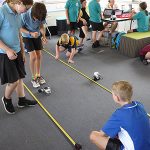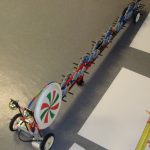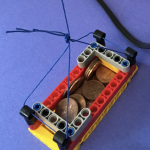
The challenge
Design and build a car that can climb as steep a ramp as possible.
Engineers repeatedly test their creations and use the results to make improvements to their designs. As you test your car on the ramp, pay attention to what goes wrong–does the car veer to one side, flip over, slide? Noting how the car fails may help you decide what change to try next.
Materials needed
- LEGO pieces for building a motorized one-motor or two-motor car.
- Additional LEGO beams, wheels, and gears
- Board for creating a ramp
- Protractor or app for measuring the ramp’s angle of incline
Notes for the teacher
- This activity can be done using MINDSTORMS EV3 or NXT, WeDo, BOOST, or Power Functions motors and battery packs.
- To construct the ramp, you will need a sturdy board approximately one-meter long. To make the angle adjustable, you can support the top of the board on a bookshelf, moving the top from shelf to shelf to adjust the angle.
- Encourage the students to make only one change at a time and then evaluate it. Many of the students will be tempted to implement several of their ideas at once. Point out to them that it will be much harder to determine the effect of each modification if they have made several changes between trials.
- If the students reach a dead end in trying to improve the vehicle, help them to analyze the problems they are encountering. If the wheels slip, they may want to try a different type of tires. If the car stalls in one place, they may want to gear it down to increase torque. If the car tips backward, they may want to lower its center of gravity.
- Torque enters into many aspects of this lab. First, the students can increase the torque of their motors by gearing down the cars. Second, increasing the wheel size decreases the force with which the wheel pushes against the ground since the torque of the motor is more-or-less constant and the distance to the point where the force is applied increases with the radius of the wheel. Third, the cars tend to veer sideways as the ramp gets steeper. Mounting the forward wheel(s) well in front of the heavy center part of the car will tend to counteract this tendency by producing a counter-torque.
The following two tabs change content below.


Barbara Bratzel
Barbara teaches at the Shady Hill School in Cambridge, Massachusetts and works at the Center for Engineering and Education Outreach at Tufts University. She is the author of several LEGO robotics activity books for teachers, most recently STEM by Design.
Latest posts by Barbara Bratzel (see all)
- New Cycles of Dr. E’s Challenges Are Here - 7 February 2019
- Snail Car - 23 August 2018
- Ramp Climber - 23 August 2018
- Does LEGO BOOST Have a Place in Education? - 20 January 2018
- EV3 books - 4 July 2017



How do you make the robot? What are the programs?
For the program, any code that runs the motor(s) at full power is fine. As far as building goes, there is no set building plan–the students are challenged to create their own vehicles and then test and modify them to improve their performance.